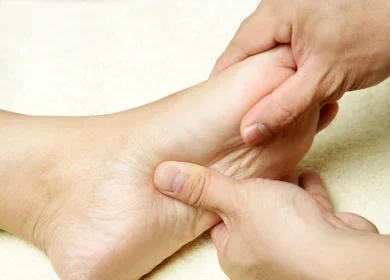
Diabetes and Your Feet
It is important to understand how your feet can change as a diabetic and you need to learn how to spot the changes. This enables you to take positive action and keep your feet healthy. This applies to both type 1 and type 2 diabetes.
Prolonged periods of high glucose levels in your blood, can damage various areas of your body, including the feet and legs. The nervous system can also be damaged by high glucose levels in the blood, this prevents important messages travelling to and from your brain. As a diabetic, nerve damage (neuropathy) is the thing most likely to affect your feet. The longest nerves in your body are those most likely to be affected – reaching to your feet and legs. Nerve damage in your feet can cause problems with: Motor (may cause the bones and toe joints to change shape) ; Autonomic (reduction in sweat production, causing dry skin) and Sensory (a loss of sensation, less able to feel temperature, pain and vibrations).
The high glucose levels in your blood can damage your blood vessels. This can restrict the blood supply to your feet and legs, the reduced circulation resulting in less blood reaching your muscles, skin and tissues.
It is a common belief among diabetics that poor circulation is responsible for many of their problems. To help to rectify this, they keep their feet as warm as possible. Foot problems are actually caused by the nerves in the feet becoming damaged. This is why it is vital that your nerves are tested at an annual diabetes review, and to inspect your feet regularly.
At your annual diabetes review, the shape and condition of your feet will be checked, along with changes to the blood supply and nerves. Symptoms can be:
Thickened toe nails
Tingling
Pins and needles
Cramp in your calves
Numbness
Shiny smooth skin
Hair loss on your feet
Your feet look pale
Your feet are hot to touch
Sores and hard skin
Lose your sense of position of your feet and legs.
It is important to seek advice, if you notice any of these symptoms. Prompt action will lead to fewer problems in the future.
Three Steps to healthy foot care:
Step 1
Inspect your feet:
If you have any wounds that are taking longer than a couple of days to heal, you should see your Podiatrist, Nurse or Doctor immediately.
Step 2
Wash your feet:
Using warm, soapy water. Making sure you dry your feet thoroughly.
Step 3
Moisturise:
Moisturise your feet to keep your skin healthy and supple.
By following these three easy steps and understanding how your diabetes affects your feet, you will be able to confidently manage your foot care and prevent many potential problems.
